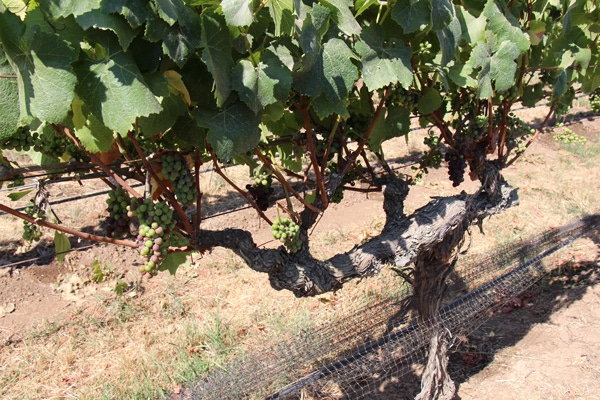
Contra Costa County farmer Matt Fernandes is all smiles when describing conditions in early June for the Cecchini Family Vineyards’ 35-acre wine grape crop.
“The vines have great vigor,” Fernandes says. “The vineyard looks the best it has in four years.
Four years ago was when he took over responsibilities for managing the operation.
His family planted the vineyard, located near Knightsen, Calif., in 2003, on land the family has owned since 1948. It features vines of Chardonnay, Marsanne, Muscat, Roussane and Zinfandel.
A total of about 12 inches of rain in December and January plus another 2 inches in February helped carry his vines through the winter. As a result, Fernandes has been able to cut his need for irrigation water this season by about 25 percent, he reports.
Fernandes irrigated his vineyards for the first time this year on March 23, followed three weeks later by a second watering. He didn’t turn on his drip system again until early this month (June).
“Our irrigation district has pre-1914 water rights, and most growers here are doing their part to reduce water use,” he says.
Powdery mildew pressure has been unusually heavy this year, Fernandes notes. Ever since spraying his vines with liquid sulfur in March to help protect them from the fungal disease, he’s been alternating between liquid sulfur treatments, which are effective for about 21 days, and applications of sulfur dust, which help control the disease for seven days, before he repeats the cycle.
“Powdery mildew can be bad sometimes in this area,” Fernandes says. “Using both materials has been effective in keeping the powdery mildew pressure down in my vineyards,” Fernandes says.
He credits mild spring weather with contributing to a good bloom, which began around the first of May – about two weeks earlier than usual – and a heavy fruit set.
“We had a lot of flowers and just about all of them set,” Fernandes says. “At mid-June, our Chardonnay looks very nice. The Marsanne and Roussanne are looking the best they ever have and our Muscat is the happiest and healthiest of them all. It looks awesome with nice, full berries. The weeds are all chopped and sprayed, the row middles are clean, there’s no powdery mildew to speak of. The table has been set for what should be a good crop.”
Meanwhile, Fernandes continues transitioning to organic practices. The heavy infestation of weeds, particularly johnsongrass and tumbleweed, that existed when he began managing the vineyards has added to the challenge of controlling weeds without conventional herbicides.
“We’re chopping weeds almost daily,” he says. “But, we’re now able to take care of most of the weed in the vine rows and middles by hand.”
He hopes to ease those chores later this month when he tries out a new weed control tool that he’s fabricated in his shop. Based on similar tools used by other growers in his area, it features a 5-foot wide blade, pulled behind a tractor, which severs the roots about two inches below the soil surface.
Two years ago, Fernandes stopped spreading bait, treated with pesticides, to control rodents. In place of them, he installed five owl boxes – one on each corner and one in the middle – in his 35-acres of grapes.
“The owls haven’t stopped the big jack rabbits,” he says. “But, they’ve done a much better job of keeping down the squirrels, gophers and moles, than I could with the poisons.”
Based on conditions in his vineyards in the middle of June, Fernandes could begin harvesting his grapes this year in late August. That would be several weeks earlier than usual for him. While an early harvest, would reduce the risk of rain damage to his crop, it’s also cause for concern. He’s still looking for contracts to sell some of his grapes.
Once they’re ripe, finding enough workers to hand-pick his grapes is another concern – one he’s familiar with.
“Getting pickers to harvest only the amount of fruit needed on any given day is tough,” Fernandes says. “When you tell them early in the afternoon that we’re done for the day, it’s difficult to get them to come back tomorrow. They want to go where they can get a full days wage.
“Once the cherry and apple harvests start, we almost always lose workers, We had a similar problem with our asparagus operation. At one time, we grew about 500 acres of asparagus. Now, we’re down to just 50 acres. We’ve replanted the rest of that ground to crops, like alfalfa, tomatoes and corn, which we can harvest with machines.”
About the Author(s)
You May Also Like




